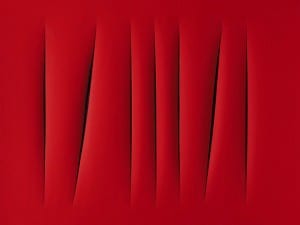Through work spanning 50 years of the artist’s long career, right up until some of his final works in the early 2000s, this exhibition at Robilant+Voena, London, will focus on Italian artist Mimmo Rotella’s fascination with innovative techniques, and bring to light the way that he manipulated material to achieve a conceptual framework, which extended from his studio into society.
Mimmo Rotella (1918-2006) came of age in Rome during the post-war period and established his place within a cultural movement alongside Alberto Burri, Ettore Colla, Carla Accardi and Cy Twombly. Rotella invented the décollage technique in 1953-1954, and remained one of its key practitioners for the rest of his life. He removed posters from city walls and examined them for meaning by tearing, scarring and excavating their layers, leaving an abstract patterning before moving on to the more figurative use of subject matter.
The artist was certainly a product of his time: his revolutionary gesture of ripping carried out a need for a more direct contact with the reality by which he was surrounded. His work also had a political undertone, he explains: “Ripping posters off walls is the only revenge, the only protest against a society that has lost its taste for change and astounding transformations. I glue the posters, then tear them: new, unpredictable forms are created. I’ve abandoned the easel to make this process…” (M. Rotella, catalogue of 1957 exhibition at Galleria d’Arte Selecta.)
In addition to using the attractive surface of posters in the décollage works, Rotella also utilised the reverse in his retro d’affiches, leaving them as they were, consequently the physical marks of the walls – plaster, dust and glue were left for all to see, producing a crater-like surface and making the material difficult to define. The exhibition will include seminal early works from the mid-1950s to the early 1960s, highlighting this vital period in the artist’s career.
The artworks will also survey Rotella’s photographic reportages and artypos of the 1960s: prints which both derive from photo-mechanical processes. However, while the photographic reportages are black and white with political focus, the artypos are characterised by vivid colour, several layers of superimposed advertising images producing an effect that is conceptually linked to the décollages. There will also be Rotella’s blanks series of the 1980s and 1990s, collages of monochrome paper on canvas or zinc which are loaded with emotive intensity. Similar to the blanks is his sovrapitture, executed on canvas or zinc sheets by applying acrylic paint to décollage.
Finally, examples of Rotella’s late décollage works from the 2000s will reveal his consistent adherence to the process which remained his most defining. Although not a retrospective as such, the overview begins around 10 years into the artist’s output, the exhibition is the first UK show to explore Rotella’s practice as a whole, bringing together a large number of works and considering his artistic development over time.
Mimmo Rotella, 6 February – 24 March, Robilant+Voena, 38 Dover Street, London, W1S 4NL.
Credits
1. Mimmo Rotella – Posso, 1963-5, screenprint on canvas, 89 x 123 cm, c.o. Robilant+Voena.
2. Mimmo Rotella – I due visi, 1962, decollage on canvas, 55 x 80 cm, c.o. Robilant+Voena.
3. Mimmo Rotella –Arachidina 1963 138 x 95.3cm.




